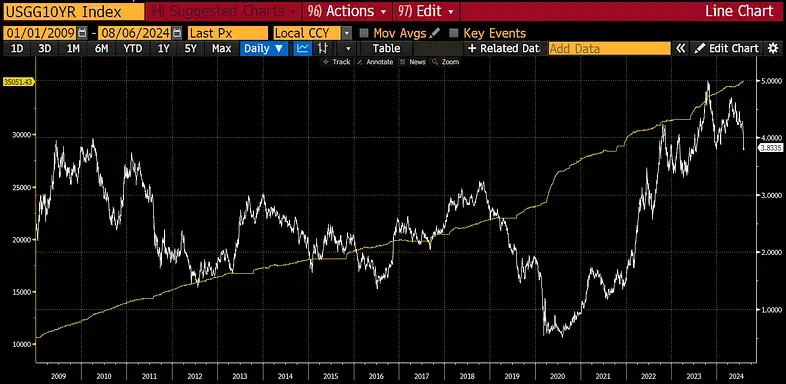What do you do when the market is down and you're going to win an election?
If you are a politician, the answer to this question is simple. Your primary goal is to secure reelection. Therefore, you print money and manipulate prices to go up.
Imagine you are Kamala Harris, the Democratic candidate for President of the United States, facing off against the powerful Orange Man (Trump). You need everything to go right because a lot of things have gone wrong since the last time you were Vice President. The last thing you need on Election Day is a raging global financial crisis.
Harris is a savvy politician. Given that she is Obama’s puppet, I bet he is warning her about how bad the 2008 Global Financial Crisis (GF) would have been if it had come to her doorstep a few months before the election. US President Joe Biden is working in his vegetable patch, so one would think Harris is in control.
In September 2008, Lehman Brothers went bankrupt, triggering a truly global financial crisis, just as George W. Bush was finishing his second term as president. Given that he was a Republican president, one could argue that part of Obama’s appeal as a Democrat was that he was a member of another party and therefore not responsible for the recession. Obama won the 2008 presidential election.
Let’s refocus on Harris’ dilemma: how to respond to the global financial crisis triggered by the unwinding of Japan’s corporate yen carry trade. She can let it run its course and let the free market destroy over-leveraged businesses and let wealthy baby boomer financial asset holders experience some real pain. Or, she can instruct U.S. Treasury Secretary bad-girl Janet Yellen to solve the problem by printing money.
Like any politician, regardless of party affiliation or economic beliefs, Harris will instruct Yellen to use the monetary tools at her disposal to avoid a financial crisis. Of course, that means the printing presses will start rolling in some way, shape, or form. Harris doesn’t want Yellen to wait—she wants Yellen to act forcefully and immediately. So if you agree with me that the unwinding of the yen carry trade could cause the entire global financial system to collapse, you also have to believe that Yellen will act no later than the opening of Asian trading next Monday (August 12).
To give you an idea of the size and magnitude of the potential impact of the unwinding of the carry trade for Japanese companies, I will walk through an excellent research note from Deutsche Bank dated November 2023. Then, I will describe how I would formulate a bailout plan if I were appointed head of the U.S. Treasury.
Why does Japan always stick to the most relaxed monetary policy?
What is a carry trade? A carry trade involves borrowing in one currency with a low interest rate and then buying a financial asset in another currency that has a higher yield or a higher likelihood of appreciation. When the loan needs to be repaid, the funds lose if the borrowed currency appreciates relative to the currency of the asset you purchased. The funds make money if the borrowed currency depreciates. Some investors hedge their currency risk, while some do not. In this case, Japanese companies do not need to hedge their borrowed yen because the Bank of Japan can print an unlimited amount of yen.
Japan Inc. refers to the Bank of Japan, businesses, households, pension funds, and insurance companies. Some entities are public, some are private, but they all work together to improve Japan, or at least they intend to.
Deutsche Bank wrote an excellent report on November 13, 2023 titled “The World’s Largest Carry Trade.” The author asks a rhetorical question: “Why didn’t the yen carry trade explode and bring down the Japanese economy?” The situation today is very different than it was at the end of last year.
The storyline is that Japan is overly indebted. Hedge fund bros are betting that Japan is going to collapse. But those who bet against Japan always lose. Many macro investors are too bearish on Japan because they don’t understand Japan’s combined public and private balance sheets. This is an easy psychological mistake to make for Western investors who believe in individual rights. But in Japan, the collective reigns supreme. Therefore, certain actors that are considered private in the West are just substitutes for the government.
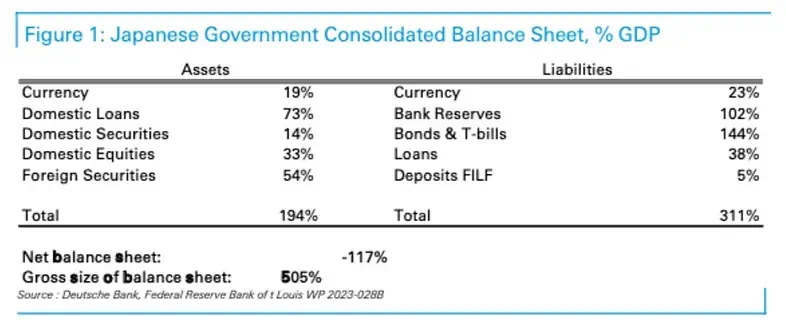
Let's deal with the liabilities first. These are where the money for the carry trade comes from. Yen is borrowed this way. They incur interest costs. The two main items are bank reserves and bonds and treasury bills.
Bank reserves – These are the funds that banks hold with the Bank of Japan. This amount is large because the Bank of Japan creates bank reserves when it buys bonds. Remember, the Bank of Japan owns nearly half of the Japanese government bond market. Therefore, the amount of bank reserves is huge, accounting for 102% of GDP. These reserves cost 0.25%, which the Bank of Japan pays to the banks. For reference, the Fed pays 5.4% for excess bank reserves. This funding cost is almost zero.
Bonds and Treasury Bills – These are Japanese government bonds issued by the government. Due to the market manipulation by the Bank of Japan, Japanese government bond yields are at rock bottom levels. As of the time of this post, the current 10-year Japanese government bond yield is 0.77%. This financing cost is negligible.
In terms of assets, the broadest item is foreign securities. These are financial assets owned abroad by the public and private sectors. One of the large private holders of foreign assets is the Government Pension Investment Fund (GPIF). With $1.14 trillion in assets, it is one of the largest pension funds in the world, if not the largest. It owns foreign stocks, bonds, and real estate.
When the Bank of Japan prices bonds, domestic loans, securities and stocks also perform well. Finally, due to the large amount of yen debt created, the depreciation of the yen pushes up the domestic stock and real estate markets.
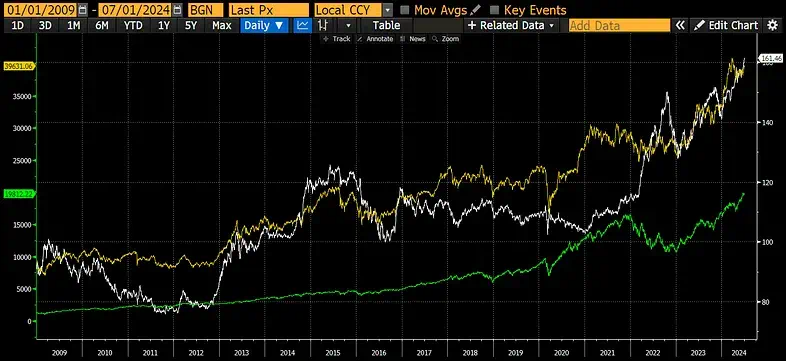
USD/JPY (white) rose, meaning the yen weakened against the dollar. The Nasdaq 100 (green) and Nikkei 225 (yellow) also rose.
Overall, Japanese companies have taken advantage of the financial repression implemented by the Bank of Japan to finance themselves and have been highly rewarded by the weak yen. This is why the Bank of Japan can continue to implement the loosest monetary policy in the world even as global inflation rises. It's really profitable.
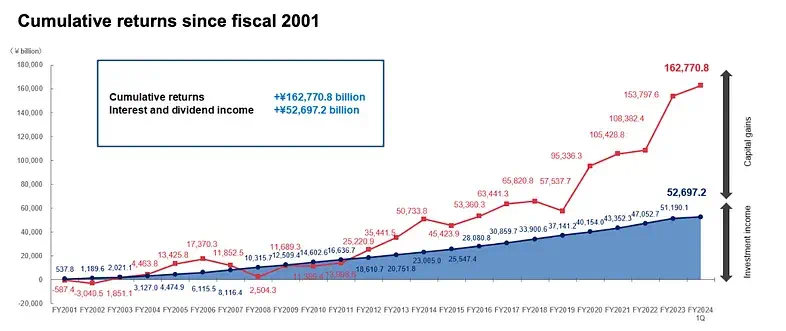
The GPIF has done well, especially in the last decade, when the yen has depreciated significantly. As the yen has depreciated, the returns on foreign assets have risen significantly.
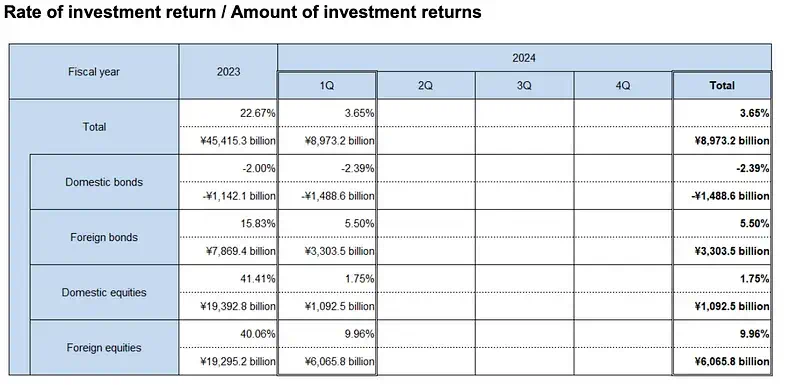
If not for the stellar returns on its overseas stock and bond portfolios, GPIF would have lost money last quarter. The domestic bond losses came as the Bank of Japan’s withdrawal of YCC caused JGB yields to rise and prices to fall. However, the yen continued to weaken as the spread between the Bank of Japan and the Fed got wider than Sam Bankman-Fried’s eye when he discovered the Emsam pill.
Japanese companies are trading massively. Japan’s GDP is about $4 trillion, and with a total exposure of 505%, they are taking on $24 trillion in value at risk. As Cardi B said, “I want you to park that big Mack truck in this little garage.” She must be rapping about the Japanese men who are in power in the land of sunset.
The deal apparently worked, but the yen became too weak. In early July, the dollar-yen exchange rate was 162, which was unsustainable because domestic inflation was raging then and is raging now.
The BoJ does not want to stop this trade immediately, but rather slowly exit it over time... they always say that. Takashi Ueda succeeds Takashi Kuroda as BoJ Governor in April 2023, who was the main architect of this massive trade. He took the opportunity to exit. Takashi Ueda is the only fool left among the qualified candidates who wanted to commit seppuku by trying to unwind this trade. The market knew that Takashi Ueda would try to get the BoJ out of this carry trade. The question is always the speed of normalization.
The Bank of Japan's Biggest Trouble
What would a disorderly liquidation look like? What would happen to the various assets held by Japanese companies? How much would the yen appreciate?
To close its position, the BOJ would need to raise interest rates by stopping its purchases of JGBs and eventually selling them back into the market.
What happens on the liability side?
If the Bank of Japan hadn’t been pushing down JGB yields, they would rise as the market demands that yields at least match inflation. Japan’s consumer price index (CPI) rose 2.8% year-on-year in June. If JGB yields rise to 2.8%, higher than any bond yield at any point on the yield curve, the cost of debt at any maturity would increase. The interest costs of bond and treasury bill liabilities would surge.
The BOJ would also have to raise interest on bank reserves to prevent those funds from escaping its clutches. Again, that cost would rise from near zero to huge, given the notional amounts involved.
In short, if interest rates were allowed to rise to market-clearing levels, the Bank of Japan would have to pay billions of yen in interest each year to maintain its position. Without the proceeds from selling assets on the other side of the book, the Bank of Japan would have to print huge amounts of yen to keep its debt serviced. Doing so would make the situation worse; inflation would rise and the yen would depreciate. Therefore, assets would have to be sold.
On the asset side, what happens?
The Bank of Japan’s biggest headache is how to sell its massive pile of JGBs. Over the past two decades, the Bank of Japan has destroyed the JGB market through its various quantitative easing (QE) and yield curve control (YCC) programs. For all intents and purposes, the JGB market no longer exists. The Bank of Japan must force another member of Japanese corporate to do its part and buy JGBs at a price that will not bankrupt the Bank of Japan.
Japanese commercial banks were forced to deleverage after the real estate and stock market bubbles burst in 1989. Bank lending has been stagnant since then. The Bank of Japan started printing money because companies were not borrowing from banks. Given that banks are in good shape, it is time to bring several quadrillion yen worth of Japanese government bonds back to their balance sheets.
While the Bank of Japan can tell banks to buy bonds, the banks need somewhere to move the capital. As JGB yields rise, Japanese companies seeking profits and banks holding trillions of dollars in overseas assets will sell those assets, repatriate the capital to Japan, and deposit it in banks. Banks and these companies will buy JGBs in large quantities. As a result of the capital inflows, the yen appreciates, and JGB yields do not rise to levels that would cause the Bank of Japan to go bankrupt when it reduces its holdings.
The biggest losses are from falling prices of foreign stocks and bonds that Japanese companies sell to generate capital repatriation. Given the sheer size of this carry trade, Japanese companies are the marginal price makers for stocks and bonds worldwide. This is especially true for any US-listed securities, as their markets are the preferred destination for funding capital for yen carry trades. Given that the yen is a freely convertible currency, many TradFi trading books reflect Japanese companies.
As the yen depreciates, more and more investors around the world are encouraged to borrow yen and buy U.S. stocks and bonds. Because the leverage is so high, as the yen appreciates, everyone will rush in at the same time.
I showed you a chart earlier that shows what happens when the yen depreciates. What happens when it appreciates a little bit? Remember the earlier chart that showed USD/JPY going from 90 to 160 in 15 years? In 4 trading days, it went from 160 to 142 and here’s what happened:
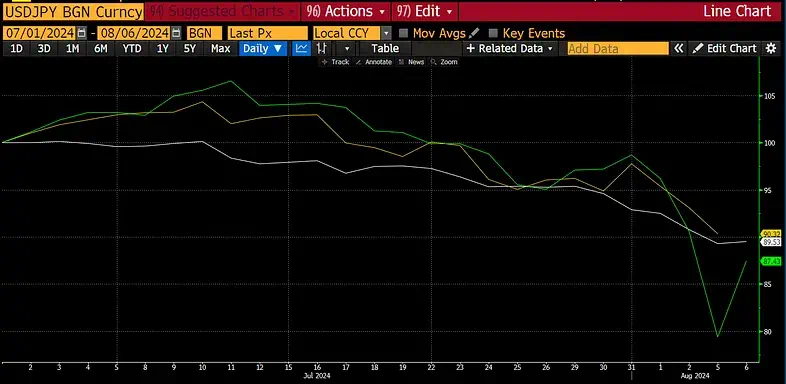
A 10% increase in USD/JPY (white) would cause the Nasdaq 100 (white) to fall 10% and the Nikkei 225 (green) to fall 13%. The percentage increase in the yen would be roughly 1:1 with the decline in the stock index. Further extrapolating, if USD/JPY reached 100, a 38% increase, the Nasdaq would fall to about 12,600 and the Nikkei would fall to about 25,365.
USDJPY to 100 is possible. A 1% reduction in Japanese corporate carry trades is equivalent to about $240 billion in notional value. This is a huge amount of capital at the margin. Different players in Japanese corporates have different secondary priorities. We saw this with Norinchubo, Japan’s fifth largest commercial bank. Their carry trade section went bust and they were forced to start unwinding their positions. They are selling foreign bond positions and covering forward USDJPY FX hedges. This announcement was made only a few months ago. Insurance companies and pension funds will be under pressure to disclose unrealized losses and exit trades. Along with them are all the copy traders whose brokers will quickly liquidate them as currency and equity volatility rises. Remember, everyone is unwinding the same trade at the same time. Neither we nor the elites who manage global monetary policy know the total size of the yen carry trade funding positions hidden in the financial system. The opacity of the situation means that an overcorrection will quickly occur in the other direction as markets gradually reveal this highly leveraged part of the global financial system.
The global financial crisis of 2008
Why would bad girl Yellen care?
Since the 2008 global financial crisis, I think China and Japan have saved Pax Americana from a worse recession. China undertook one of the largest fiscal stimulus in human history, expressed through debt-fueled infrastructure development. China needed to buy goods and raw materials from the rest of the world to complete its projects. Japan printed huge amounts of money through the Bank of Japan to increase its carry trade. Japanese companies used these yen to buy U.S. stocks and bonds.
The U.S. government has generated significant revenue from capital gains taxes, a result of soaring stock markets. From January 2009 to early July 2024, the Nasdaq 100 has risen 16-fold and the S&P 500 has risen 6-fold. Capital gains tax rates are around 20% to 40%.
The U.S. government is running a deficit despite record high capital gains taxes. To finance the deficit, the U.S. Treasury must issue bonds. Japanese companies are one of the largest marginal buyers of U.S. Treasuries…at least until the yen starts to appreciate. Japan helps afford the U.S. debt to profligate politicians who need to buy votes with tax cuts (Republicans) or various forms of welfare checks (Democrats).
Total U.S. debt outstanding (yellow) is in the upper right. However, the 10-year Treasury yield (white) has been range-bound, showing little correlation with the growing debt.
My view is that the structure of the U.S. economy requires that Japanese companies and their imitators continue to engage in this arbitrage trade. If this trade ends, the U.S. government's finances will be in tatters.
Rescue Plan
My assumption of a coordinated bailout of Japanese corporate carry trade positions is based on the belief that Harris will not have her electoral chances diminished because some foreigners decided to exit some trade that she may not even understand. Her voters certainly don’t know what’s going on and don’t care. Their stock portfolios are either up or they aren’t. If not, they won’t show up on Election Day to vote Democrat. Turnout will determine whether the clown emperor is Trump or Harris.
Japanese companies have to close their positions, but they can't sell certain assets on the open market. This means that some government agencies in the United States have to print money and lend it to certain members of Japanese companies. Please allow me to reintroduce myself. My name is Central Bank Swap Agreement (CSWAP).
If I were bad girl Yellen, how would I rescue her?
On Sunday evening, August 11, I will issue a communique (I am speaking as Janet Yellen):
The U.S. Treasury, the Federal Reserve, and our Japanese counterparts discussed at length the market turmoil of the past week. During this call, I reiterated my support for the use of the U.S. dollar-yen central bank swap lines.
That's it. To the public, it seems totally harmless. It's not a statement for the Fed to cave and do aggressive rate cuts and restart quantitative easing. It's because the public knows that doing any of those things would cause already uncomfortably high inflation to accelerate again. If inflation runs rampant on Election Day and it can be easily traced back to the Fed, Harris loses.
Most American voters have no idea what CSWAP is, why it was created, or how it can be used to print unlimited amounts of money. Yet the market will rightly view this as a stealth bailout because of what the tool will be used for.
The Bank of Japan borrows billions of dollars and provides yen as collateral to the Fed. These swaps are rolled over as often as the Bank of Japan decides.
The Bank of Japan has privately spoken to big companies and banks, telling them it is prepared to exchange dollars for U.S. stocks and Treasuries.
This transfers ownership of foreign assets from Japanese companies and banks to the BoJ. These private entities own large amounts of USD and repatriate this capital to Japan by selling USD and buying JPY. They then buy JGBs from the BoJ at the current high prices/low yields. The result is an inflated size of CSWAPS outstanding, and this USD amount is similar to the amount of money the Fed is printing.
I created an ugly box and arrow plot that will help illustrate the flow.
It’s the net effect that matters.
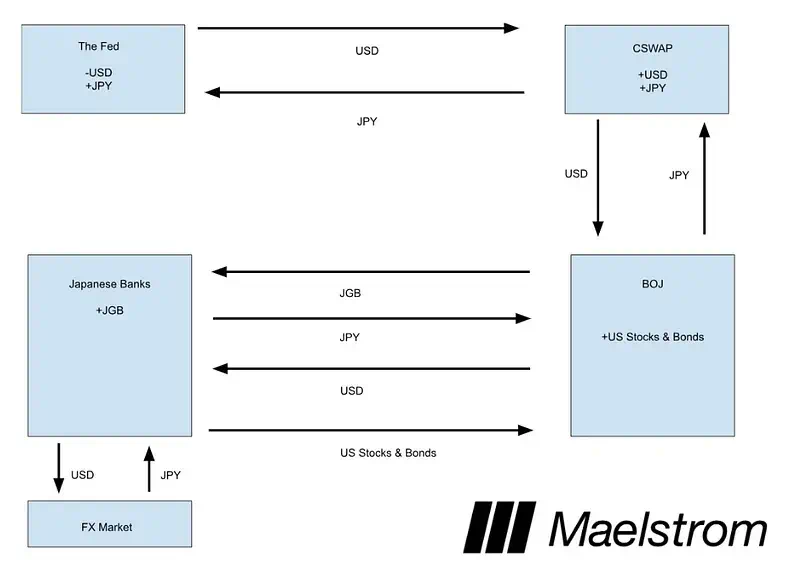
The Federal Reserve - they increase the supply of dollars, in other words, in return they get the yen that was previously generated by the growth of the carry trade.
CSWAP - The Bank of Japan owes the Federal Reserve dollars. The Federal Reserve owes the Bank of Japan yen.
Bank of Japan - They now hold more US stocks and bonds, and as the amount of dollars increases due to the growing CSWAP balance, the prices of these stocks and bonds will rise.
Bank of Japan - they now hold more Japanese government bonds.
As you can see, there was no impact on the US stock or bond markets, and the total carry trade exposure for Japanese companies remained the same. The yen appreciated against the dollar, and most importantly, US stock and bond prices rose because the Fed was printing dollars. As an added bonus, Japanese banks could issue unlimited yen-denominated loans against their newly acquired JGB collateral. This trade re-inflated both the US and Japanese systems.
Cryptocurrency trading advice
The carry trades of Japanese companies will be unwound; of that I am sure. The question is when the Fed and Treasury will start printing money to mitigate the impact on Pax Americana.
If the US stock market crashes on Friday, August 9, so that both the S&P 500 and the Nasdaq 100 fall 20% from their recent July all-time highs, some kind of action could be expected over the weekend. The level for the S&P 500 is 4,533; the level for the Nasdaq 100 is 16,540. I also expect the 2-year US Treasury yield to be around 3.80% or lower. This yield was reached during the regional banking crisis in March 2023, which was resolved through a bank term funding program bailout.
If the yen starts to depreciate again, the crisis will end in the short term. Although the pace will slow down, the liquidation will continue. I think the market will have another tantrum between September and November as the USD/JPY pair continues to move towards 100. This time there will definitely be a response because the US presidential election will be held in a few weeks or days.
Trading in cryptocurrencies is difficult.
Two opposing forces influence my cryptocurrency positioning.
The positive force of liquidity:
After a quarter of net restrictive policy, the US Treasury will be a net injector of USD liquidity as it will issue T-bills and likely drain the Treasury General Account. This policy shift was spelled out in the recent quarterly refunding announcement. TL;DR: Bad Girl Yellen will inject $301 billion to $1.05 trillion between now and the end of the year. I will explain this in a follow-up post if necessary.
Negative forces of liquidity:
This is the strength of the yen. The unwinding of the deal led to a coordinated global sell-off of all financial assets as increasingly expensive yen debts had to be repaid.
Which force is stronger really depends on how quickly the carry trades are unwound. We have no way of knowing this in advance. The only observable effect is the correlation between Bitcoin and USD/JPY. If Bitcoin trades in a convex manner, meaning that Bitcoin rises when the USD/JPY pair strengthens or weakens significantly, then I know that if the yen is too strong and liquidity provided by the US Treasury is plentiful, the market will anticipate a bailout. This is convex Bitcoin. If Bitcoin falls when the yen strengthens and rises when the yen weakens, then Bitcoin will trade in sync with the TradFi market. This is correlated Bitcoin.
If the market is pointing to convex Bitcoin, I will be aggressively adding to my position as we have hit a local bottom. If the market is pointing to correlated Bitcoin, then I will be sitting on the sidelines waiting for eventual market capitulation. The biggest assumption is that the BoJ does not change course and cut the deposit rate to 0% and resume unlimited JGB purchases. If the BoJ sticks to the plan laid out at the last meeting, carry trades will continue to unwind.
This is the clearest guidance I can give at this time. As always, these trading days and trading months will determine your returns in this bull cycle. If you must use leverage, use it wisely and constantly monitor your positions. When you have a leveraged position, you better hold onto your bitcoin or shit coin. Otherwise, you will be liquidated.
I still have the last bit of August vacation left to enjoy.


